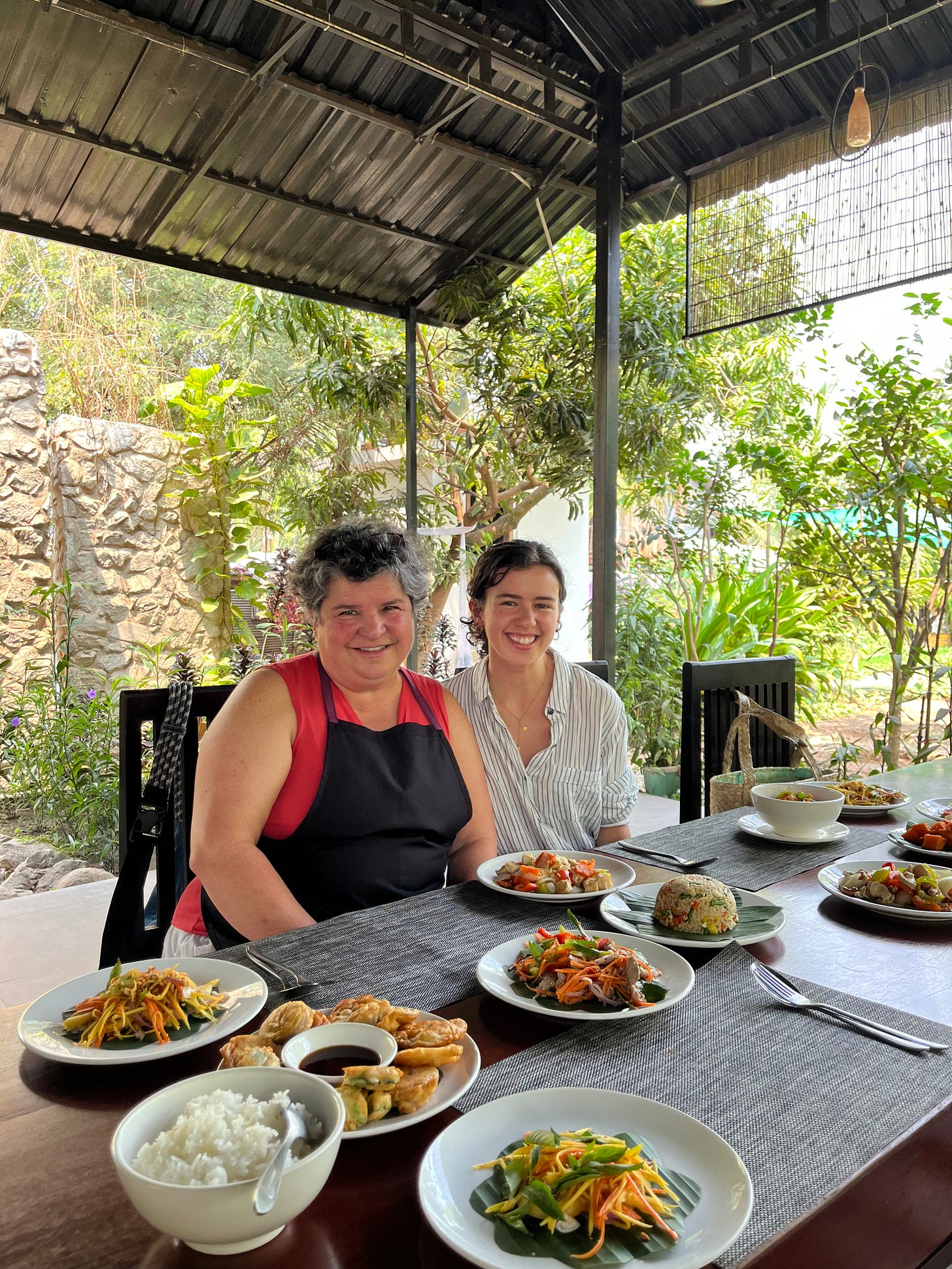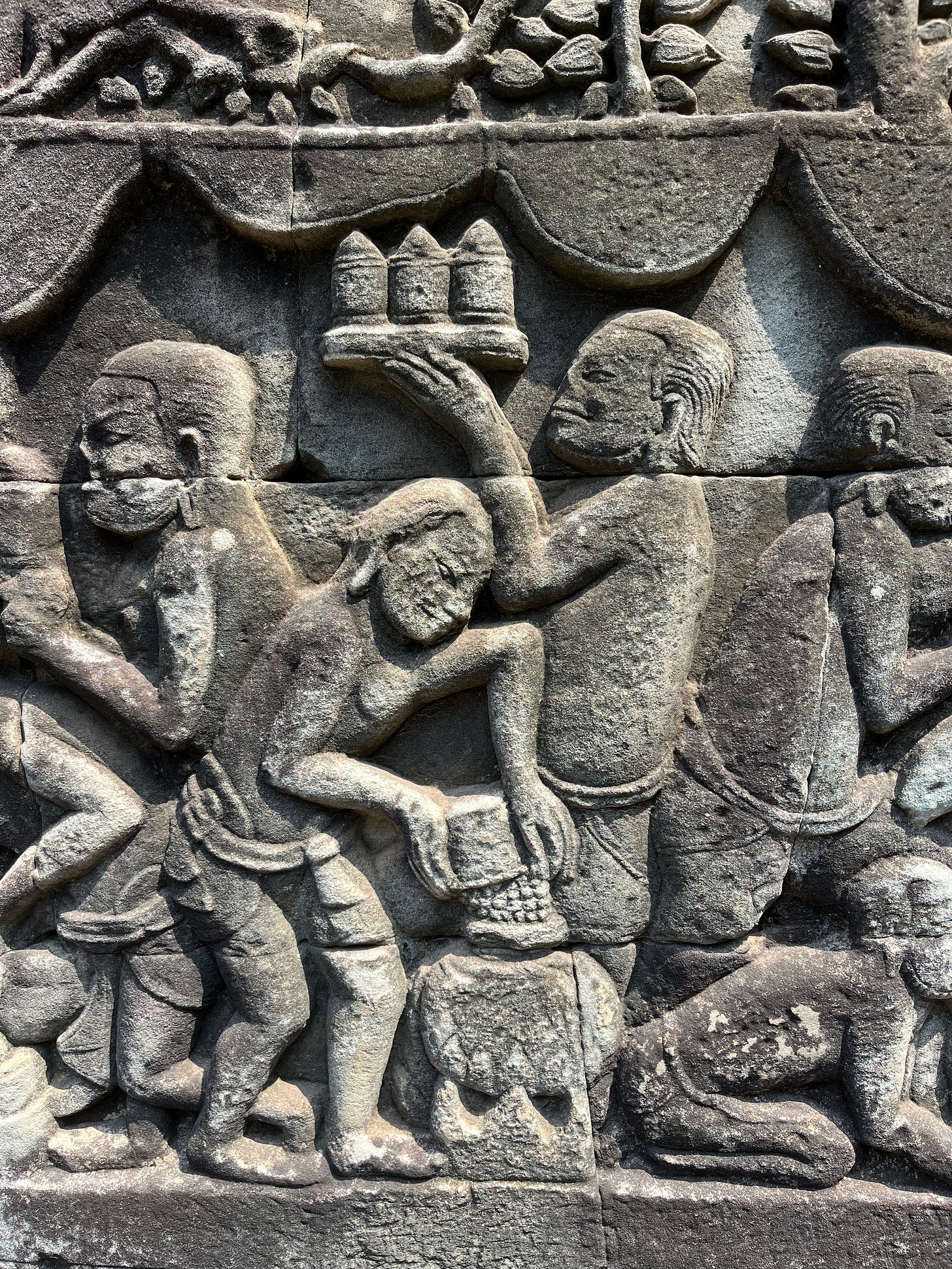From the rice fields of Siem Reap, Cambodia
Learning about Cambodia's history, biking the countryside, and taking a Khmer-style cooking class.
For thousands of years, rice has been an over-arching theme in Cambodia. Whether visiting ancient temples or biking the countryside, rice is an inescapable manifestation of Cambodia’s history and culture. The following is what I learned from my week in Siem Reap.
Essential Cambodian History
Arriving in Cambodia, I had basically zero knowledge of the country. It wasn’t long before I learned about the Cambodian genocide, something I don’t recall from my schooling. From 1965 to 1973, the United States dropped nearly three millions tons of bombs on Cambodia. This tactic, used to stifle Vietnamese use of the Ho Chi Minh Trail during the Vietnam War, was devastating for Cambodians. The country was already entrenched in civil war, the Cambodian monarchy against the Cambodian communists, as income inequality pitted the urban against the rural. With a low estimate of 250,000 civilian deaths, US bombing fueled the civil war as the Cambodian communists, the Khmer Rouge, “use the bombing’s killing and destruction as recruitment propaganda and as an excuse for the abandonment of moderate socialist policies in the insurgent zones”. Essentially, US bombing empowered the Khmer Rouge to take over in 1975, which incited the Cambodian genocide.
Lasting for four years (between 1975 and 1979), the Cambodian Genocide was an explosion of mass violence that saw between 1.5 and 3 million people killed at the hands of the Khmer Rouge, a communist political group. The Khmer Rouge had taken power in the country following the Cambodian Civil War. During their brutal four-year rule, the Khmer Rouge was responsible for the deaths of nearly a quarter of Cambodians.
The Cambodian Genocide was the result of a social engineering project by the Khmer Rouge, attempting to create a classless agrarian society.
Source: The University of Minnesota: Holocaust and Genocide Studies
For executions, the Khmer Rouge targeted doctors, lawyers, and teachers, and even people with glasses or light-skin (which were assumed to be signs of prestige). They forced city dwellers to the countryside to be farmers and killed anyone who couldn’t comply, like old women, young children, and hospital patients. Those who survived the forced evacuations worked in the rice fields and dug trenches. Children of Cambodia’s Killing Fields by Teeda Butt Mam is a short first-hand account published by the New York Times which I would recommend to anyone wanting to get a brief sense of what it was like to survive through these atrocities. The Paris Agreement was finally implemented in 1991 which stabilized the country and opened it up to the world.
Tourism seems like an essential industry in Cambodia, at the very least an industry which a lot of Cambodians at present depend upon. People seem drawn to visit Cambodia for the unique offerings of the ancient Khmer empire and Angkor Wat, various Buddhist and Hindu temples, startling aforementioned 20th century events, breathtaking landscapes, phenomenal food, and a beautiful and resilient culture. I’ve been grateful for the opportunity, however brief and limited, to experience this place and it’s people.
Biking the Countryside
Just a few minutes from downtown Siem Reap, rice fields begin to sprawl. On a guided bike tour, we saw expansive rice fields, vegetable gardens, mushroom farms, and lotus farms. We also visited a local market and rice wine distillery. My favorite part of the tour was enjoying the peacefulness of the countryside and witnessing how connected Cambodians are to their agriculture. With the latter point, when people are connected to their agriculture it makes sense that plentiful rice translates to eating rice three times a day. Cambodians and their diets are harmonious with what they grow and is found around them.
Cooking Khmer-Style
My mom and I enjoyed a Khmer-style cooking class. It was a lot of fun to be assisted in the kitchen with people so knowledgeable and fond of their cuisine. They had a home garden growing beside the outdoor kitchen where we helped prepared our meal, and I relished making curry paste with plants growing just a few feet from me. As a proponent of local and ethical eating, it was exceptionally novel to savor bananas, mangoes, coconut milk, and cashews with peace of mind. Between eating my favorite novelties, sourcing food locally, supporting local growers and chefs, and cooking and eating alongside my mom, this experience was quadruply yummy.

Blog Updates
Intereating will now post twice a week: Mondays and Fridays. On Mondays, I will provide a kind of narrative update on what’s present in my life. With whatever I write about, I’ll share the recipes and readings that I find inspiring at that moment. For Fridays, my goal is to have y’all writing and sharing your wisdoms. Yes, you. I know that it’s a daunting task, however, it’s worthwhile to work with and through that hesitation to recognize and honor your inherent wisdom, to share with and feel connected to others. So begin brainstorming what you want to write about, an experience, a favorite recipe, a concept, etc., and get in touch!
Eating
Over the past week, I’ve enjoyed various curries, spring rolls, and cashew-nut stir-fries. Here is an Amok style vegan curry to bring a taste of Cambodia to your kitchen. This curry is essentially what I learned to make in our cooking class.
Reading
I just finished Crying in H-Mart by Michelle Zauner. In her book, Zauner details the heart-wrenching complexities of losing her mother as a young adult, and how food is the force binding them in life and death. It is a phenomenal composition of love, and one of my new favorite books. This is our Intereating bookclub’s March selection, so feel free to join us March 26th at 6pm eastern time.
Check out my lastest inspiration, Alicia Kennedy, and her breadth of knowledge regarding culinary tourism.






What a remarkably informative and fascinating glimpse into Cambodian life, rice and history! Thanks for sharing your deeply thoughtful experience.
It was such a pleasure learning and enjoying Cambodia with you! Ir was truly a remarkable experience. ❤️